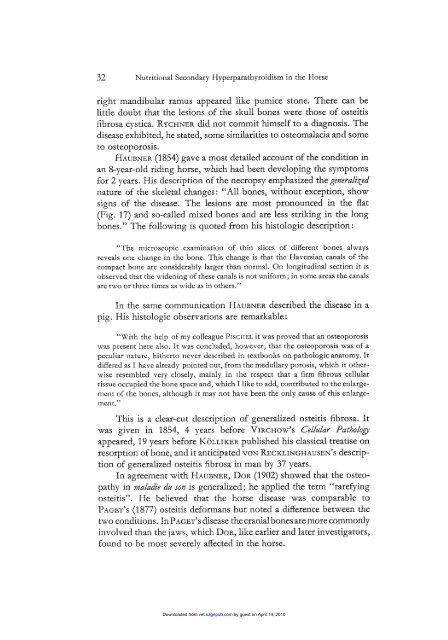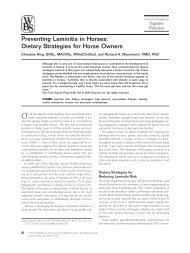Nutritional Secondary Hyperparathyroidism in the Horse
Nutritional Secondary Hyperparathyroidism in the Horse
Nutritional Secondary Hyperparathyroidism in the Horse
Create successful ePaper yourself
Turn your PDF publications into a flip-book with our unique Google optimized e-Paper software.
32 <strong>Nutritional</strong> <strong>Secondary</strong> <strong>Hyperparathyroidism</strong> <strong>in</strong> <strong>the</strong> <strong>Horse</strong><br />
right mandibular ramus appeared like pumice stone. There can be<br />
little doubt that <strong>the</strong> lesions of <strong>the</strong> skull bones were those of osteitis<br />
ilbrosa cystica. RYCHNER did not commit himself to a diagnosis. The<br />
disease exhibited, he stated, some similarities to osteomalacia and some<br />
to osteoporosis.<br />
HAUBNER (1854) gave a most detailed account of <strong>the</strong> condition <strong>in</strong><br />
an 8-year-old rid<strong>in</strong>g horse, which had been develop<strong>in</strong>g <strong>the</strong> symptoms<br />
for 2 years. His description of <strong>the</strong> necropsy emphasized <strong>the</strong> generalized<br />
nature of <strong>the</strong> skeletal changes: “All bones, without exception, show<br />
signs of <strong>the</strong> disease. The lesions are most pronounced <strong>in</strong> <strong>the</strong> flat<br />
(Fig. 17) and so-called mixed bones and are less strik<strong>in</strong>g <strong>in</strong> <strong>the</strong> long<br />
bones.” The follow<strong>in</strong>g is quoted from his histologic description :<br />
“The microscopic exam<strong>in</strong>ation of th<strong>in</strong> slices of different bones always<br />
reveals one change <strong>in</strong> <strong>the</strong> bone. This change is that <strong>the</strong> Haversian canals of <strong>the</strong><br />
compact bone are considerably larger than normal. On longitud<strong>in</strong>al section it is<br />
observed that <strong>the</strong> widcn<strong>in</strong>g of <strong>the</strong>se canals is not uniform; <strong>in</strong> some areas <strong>the</strong> canals<br />
arc two or three times as wide as <strong>in</strong> o<strong>the</strong>rs.”<br />
In <strong>the</strong> same communication HAUBNER described <strong>the</strong> disease <strong>in</strong> a<br />
pig. His histologic observations are remarkable :<br />
“With <strong>the</strong> help of my colleague PISCIIEL it was proved that an osteoporosis<br />
was present here also. It was concluded, however, that <strong>the</strong> osteoporosis was of a<br />
peculiar nature, hi<strong>the</strong>rto never described <strong>in</strong> textbooks on pathologic anatomy. It<br />
differed as I have already po<strong>in</strong>ted out, from <strong>the</strong> medullary porosis, which it o<strong>the</strong>rwise<br />
resembled very closely, ma<strong>in</strong>ly <strong>in</strong> <strong>the</strong> respect that a firm fibrous cellular<br />
tissue occupied <strong>the</strong> bone space and, which I like to add, contributed to <strong>the</strong> enlargement<br />
of <strong>the</strong> bones, although it may not have been <strong>the</strong> only cause of this enlargement.”<br />
This is a clear-cut description of generalized osteitis fibrosa. It<br />
was given <strong>in</strong> 1854, 4 years before VIRCHOW’S Cellzdar Pathology<br />
appeared, 19 years before KOLLIKER published his classical treatise on<br />
resorption of bone, and it anticipated VON RECKLINGHAUSEN’S description<br />
of generalized osteitis f-ibrosa <strong>in</strong> man by 37 years.<br />
In agreement with HAUBNER, DOR (1902) showed that <strong>the</strong> osteopathy<br />
<strong>in</strong> maladie dzt son is generalized; he applied <strong>the</strong> term “rarefy<strong>in</strong>g<br />
osteitis”. He believed that <strong>the</strong> horse disease was comparable to<br />
PAGET’S (1877) osteitis deformans but noted a difference between <strong>the</strong><br />
two conditions. In PAGET’S disease <strong>the</strong> cranial bones are more commonly<br />
<strong>in</strong>volved than <strong>the</strong> jaws, which DOR, like earlier and later <strong>in</strong>vestigators,<br />
found to be most severely affected <strong>in</strong> <strong>the</strong> horse.<br />
Downloaded from<br />
vet.sagepub.com by guest on April 14, 2010



